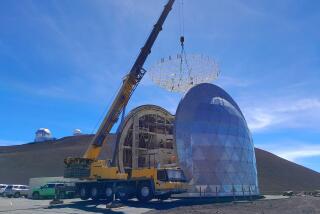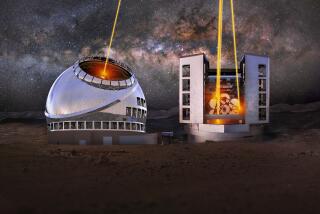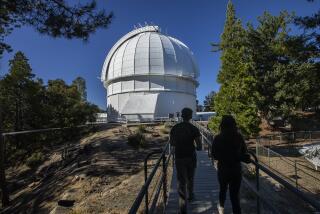Bill Gordon dies at 92; designer of the massive Arecibo radio telescope
- Share via
Bill Gordon, who designed a massive radio telescope in Arecibo, Puerto Rico, arranged funding, shepherded it through construction and was its first director, died Tuesday of natural causes in Ithaca, N.Y. He was 92.
Non-astronomers might not be familiar with the name of the Arecibo Observatory, but film buffs will recognize the massive dish, sunk in a limestone sinkhole in the picturesque hills of the island country and was featured in the 1997 film “Contact” and the 1995 James Bond film “GoldenEye.”
Completed in 1963, the telescope has played a major part in a number of scientific discoveries. It was the first to detect ice on Mercury, deep in craters on the poles of the solar system’s hottest planet, and accurately measured the planet’s rotational period. It has long been used to study radio pulsars, rapidly rotating neutron stars.
In 1974, astrophysicists Russell A. Hulse and Joseph H. Taylor Jr. used it to discover the first binary pulsar, a feat that led to a new understanding of gravitation and won them the 1993 Nobel Prize in physics. In 1990, it was used in the first discovery of planets outside our solar system, circling a pulsar in the constellation Virgo.
Gordon was not originally interested in using the telescope for astronomy. His goal was probing the atmosphere at an altitude of 1,000 to 2,000 miles, where “weather” conditions might affect the flight of missiles and satellites. He hoped to observe the behavior of clouds of electrons, which are a measure of temperature.
But to make such measurements, he calculated he needed a dish 1,000 feet across. The largest radio telescope at the time was only 150 feet across and the largest optical telescope only 100 inches.
In the late 1950s, the Navy attempted to build a 600-foot radio telescope that could capture Russian radio signals that bounced off the moon, but it collapsed under its own weight. Anything that was light enough to move to track objects in the sky was not rigid enough to focus a signal on its collector. Gordon decided the telescope would have to be sunk into the ground for support and have a movable collector to focus the dish.
The telescope also needed to be near the equator to get the best view of the planets. In 1958, the year he dreamed up the telescope, Gordon identified the limestone pit on a tobacco farm near Arecibo that ultimately became the site. He wheedled $10 million from the Department of Defense and construction began in 1960 and was completed three years later.
Although Gordon originally designed the telescope to last 10 years, it has been upgraded twice and is still providing valuable data.
At the telescope’s 40th anniversary celebration, Gordon said: “When we were talking about building [the telescope] back in the late ‘50s, we were told by eminent authorities it couldn’t be done. We were in the position of trying to do something that was impossible, and it took a lot of guts. . . . We were young enough that we didn’t know we couldn’t do it. It took five years from idea to dedication, and that is short. But we were in the right place at the right time and had the right idea and the right preparation. We had no rules or precedents.”
William Edwin Gordon was born Jan. 8, 1918, in Paterson, N.J. He earned a bachelor’s degree from Montclair State Teacher’s College in 1939. In 1942, he interrupted his education to enlist in the Army Air Corps as a meteorologist, but his attention was redirected to studying the effects of weather on the new technology of radar.
After the war, he completed his doctorate in engineering at Cornell University, where he became a faculty member. In 1966, he moved to Rice University, where he served as professor, dean, provost and vice president, retiring in 1985.
His wife of 61 years, the former Elva Freile, died in 2002. Gordon is survived by his second wife, the former Mary Elizabeth Bolgiano; a daughter, Nancy; a son, Larry; four grandchildren; and three great-grandchildren.






